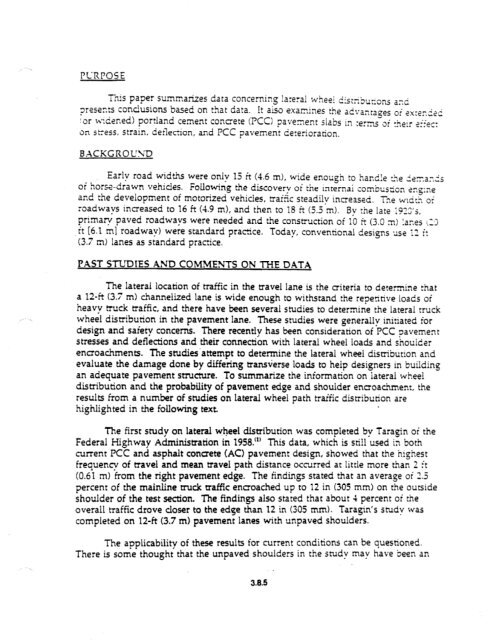chapter 3 rigid pavement - DOT On-Line Publications - Department ...
chapter 3 rigid pavement - DOT On-Line Publications - Department ...
chapter 3 rigid pavement - DOT On-Line Publications - Department ...
You also want an ePaper? Increase the reach of your titles
YUMPU automatically turns print PDFs into web optimized ePapers that Google loves.
PURPOSE<br />
This paper summarizes data concerning la:erai whee! Cis:;;j~,om azb<br />
Tresents condusions based on that data. It aiso examines the advantages of ex:er.d?~<br />
!or w:dened) portland cement concrete (KC) pavernent slabs in :erms of +,e!r e+c:<br />
on stress, strain, detlection, and KC <strong>pavement</strong> deterioration.<br />
B.ACKGROZ;‘ND<br />
Early road widths were only 15 fi (3.6 mf, wide enough to handle +,e i.exlan&<br />
of horse-drawn vehicles. Following the discovery of the internai combustion eng:ne<br />
and the development of motorized vehicles, traffic steadilv increased. Tze wtd:,? or<br />
roadways increased to 16 ft (4.9 m), and then to 18 ft (5.3 ‘m). Bv the late 1925’s.<br />
primary paved roadways were needed and the construction of lb ti (3.0 m) lar,es :X<br />
it [6.1 m] roadway) were standard practice. Today, conventional designs use I2 t’:<br />
(3.7 m) lanes as standard practice.<br />
PAST STUDIES AND COMMENTS ON THE DATA<br />
The lateral location of traffic in the travel lane is the criteria to determine that<br />
a 12-h (3.7 III) channeiized lane is wide enough to withstand the re+tive loads of<br />
heavy truck traffic, and there have been several studies to determine the lateral truck<br />
wheel distribution in the <strong>pavement</strong> lane. These studies were generally initiated for<br />
design and safety concerns. There recently has been consideration of PCC Tavement<br />
stresses and deflections and their connection with lateral wheel loads and shouider<br />
encroachments. The studies’attempt to detexmine the lateral wheei distribution and<br />
evaluate the damage done by differing transverse loads to help designers in building<br />
an adequate <strong>pavement</strong> structure. To summarize the information on lateral whee!<br />
distribution and the probability of <strong>pavement</strong> edge and shoulder encroachment, the<br />
results from a number of studies on lateral wheel path trtific distribution are<br />
highlighted in the following text<br />
The first study on lateral wheel distribution was completed by Taragin oi the<br />
Federal Highway Administration in 1958.“’ This data, which is sti!l used in both<br />
current PCC and asphalt concrete (AC) <strong>pavement</strong> design, showed that the highest<br />
frequency of travel and mean travel path distance occurred at little more than 2 !t<br />
(0.61 m> from the right <strong>pavement</strong> edge. The findings stated that an average oi 2.3<br />
percent of the mainline truck traffic encroached up to 12 in (305 mm) on the outside<br />
shoulder of the test section. The findings aiso stated that about 4 percent of the<br />
overall traffic drove cioser to the edge than 12 in (305 mm). Taragin’s study was<br />
completed on 124 (3.7 m) <strong>pavement</strong> lanes with unpaved shoulders.<br />
The applicability of these results for current conditions can be questioned.<br />
There is some thought that the unpaved shoulders in the study may have been an<br />
3.8.5
















